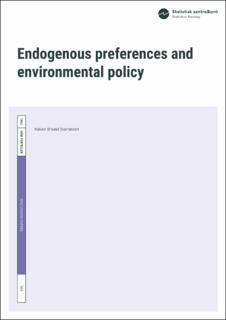| dc.contributor.author | Storrøsten, Halvor Briseid | |
| dc.date.accessioned | 2021-10-05T09:10:12Z | |
| dc.date.available | 2021-10-05T09:10:12Z | |
| dc.date.issued | 2021-10 | |
| dc.identifier.issn | 1892-753X | |
| dc.identifier.uri | https://hdl.handle.net/11250/2787652 | |
| dc.description.abstract | This paper investigates environmental policy in the presence of endogenous preferences. The optimal time trajectory is achieved if and only if the consumer is perfectly time-consistent. The suboptimal trajectories do not only differ from the optimal path during the transition between two equilibria, but also the new stationary states differ. A key difference is more pollution in the suboptimal equilibrium. If the consumer is less than perfectly time-consistent, the standard Pigou tax can be complimented with taxes and subsidies to implement the optimal time trajectory. If this option is unavailable to the regulator, a second-best option is a single tax that is above the Pigouvian level. The results in this paper indicate that the integrated assessment models used by the Intergovernmental Panel on Climate Change (IPCC) to derive optimal emission paths may recommend too high carbon emissions. | en_US |
| dc.description.sponsorship | The author appreciates financial support from the Research Council of Norway. | en_US |
| dc.language.iso | eng | en_US |
| dc.publisher | Statistisk sentralbyrå | en_US |
| dc.relation.ispartofseries | Discussion Paper;No. 964 | |
| dc.rights | Navngivelse-DelPåSammeVilkår 4.0 Internasjonal | * |
| dc.rights.uri | http://creativecommons.org/licenses/by-sa/4.0/deed.no | * |
| dc.subject | Regulation | en_US |
| dc.subject | Endogenous preferences | en_US |
| dc.subject | Habits | en_US |
| dc.title | Endogenous preferences and environmental policy | en_US |
| dc.type | Working paper | en_US |
| dc.source.pagenumber | 25 | en_US |

